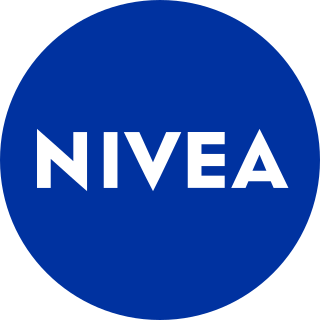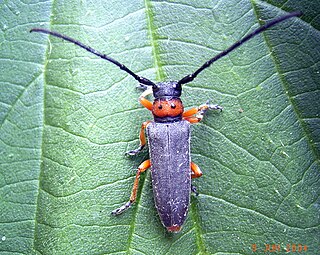
Nivea B. Hamilton, better known by her mononym Nivea, is an American R&B singer whose recordings reached the Billboard charts during the early 2000s. Nivea is known most for her Grammy-nominated hit "Don't Mess with My Man" as well as "Laundromat" and "Okay" featuring YoungbloodZ & Lil' Jon. She has released three studio albums: Nivea (2001), Complicated (2005), Animalistic (2006), and an independently released extended play Nivea: Undercover (2011). In 2019, she released her album Mirrors, including the single "Circles".

Nivea is a German personal care brand that specializes in skin and body care. It is owned by the Hamburg-based company Beiersdorf Global AG. This was the origin of Eucerin brand. Nivea comes from the Latin adjective niveus, nivea, niveum, meaning "snow-white".

Beiersdorf AG is a German multinational company that manufactures personal-care products and pressure-sensitive adhesives headquartered in Hamburg, Germany. Its brands include Elastoplast, Eucerin, Labello, La Prairie, Nivea, Tesa SE and Coppertone.

The snow petrel is the only member of the genus Pagodroma. It is one of only three birds that have been seen at the Geographic South Pole, along with the Antarctic petrel and the south polar skua, which has the most southerly breeding sites of any bird, inland in Antarctica.

Nivea is the debut studio album by American R&B singer Nivea. It was released by Jive on September 25, 2001. A contemporary R&B album with major influences of the pop and hip hop genres, Nivea worked with a wide range of producers and songwriters on her self-titled album which features credits by Leslie Braithwaite, Bryan-Michael Cox, Roy "Royalty" Hamilton, R. Kelly, The Neptunes, Organized Noise, Adonis Shropshire, Teedra Moses, Johnta Austin, and Ne-Yo, among others.

Nívea Maria Cândido Graieb is a Brazilian actress.

Phytoecia is a genus of longhorn beetles of the subfamily Lamiinae,

"Laundromat" is a song by American singer Nivea from her 2002 self-titled debut album. Jive released it in the UK as a double A-side single along with "Don't Mess With My Man" on April 28, 2003. R. Kelly wrote and produced "Laundromat", and performed some uncredited vocals on the recording, which is an R&B and pop track. It was recorded and mixed in Chicago, and was one of the last songs to be produced for the album. The track is structured as a telephone call in which Nivea breaks up with her boyfriend, who is played by Kelly. The lyrics use the laundromat as a metaphor for the washing away of an old relationship.
Phytoecia gianassoi is a species of beetle in the family Cerambycidae. It was described by Sama in 2007 and later reclassified to the subgenus Coptosia within the genus Phytoecia.

Phytoecia puncticollis is a species of beetle in the family Cerambycidae. It was described by Faldermann in 1837. It is known from Russia, Azerbaijan, Georgia, Iraq, Armenia, Turkey, Iran, and Turkmenistan. It feeds on Eryngium billardierei.
Phytoecia gaubilii is a species of beetle in the family Cerambycidae. It was described by Mulsant in 1851. It is known from Tunisia and Algeria.

Phytoecia comes is a species of beetle in the family Cerambycidae. It was described by Henry Walter Bates in 1884. It is known from Taiwan, Myanmar, North Korea, South Korea, China, Vietnam, and Japan.
Phytoecia humeralis is a species of beetle in the family Cerambycidae. It was described by Waltl in 1838, originally under the genus Saperda. It is known from Palestine, Greece, Georgia, Iran, Azerbaijan, Syria, Cyprus, and Turkey. It feeds on Silybum marianum.
Phytoecia millefolii is a species of beetle in the family Cerambycidae. It was described by Adams in 1817, originally under the genus Saperda. It has a wide distribution between Europe and the Middle East.

Phytoecia affinis is a species of beetle in the family Cerambycidae. It was described by Harrer in 1784, originally under the genus Leptura. It has a wide distribution in Europe.

Phytoecia caerulescens is a species of beetle in the family Cerambycidae. It was described by Scopoli in 1763, originally under the genus Leptura. It has a wide distribution in Europe, and has been introduced into Australia. It feeds on Echium vulgare, Lappula squarrosa, Anchusa officinalis, Lithospermum officinale, and Cynoglossum officinale.

Phytoecia caerulea is a species of beetle in the family Cerambycidae. It was described by Scopoli in 1772, originally under the genus Leptura. It has a wide distribution in Europe.
Phytoecia hirsutula is a species of beetle in the family Cerambycidae. It was described by Frölich in 1793, originally under the genus Saperda. It has a wide distribution between Europe and the Middle East.
The 2019–20 Super League Greece was the 84th season of the Super League, the top Greek professional league for association football clubs, since its establishment in 1959.
The 2020–21 Super League Greece was the 85th season of the Super League Greece, the top Greek professional league for association football clubs, since its establishment in 1959. Olympiacos were the defending champions.












